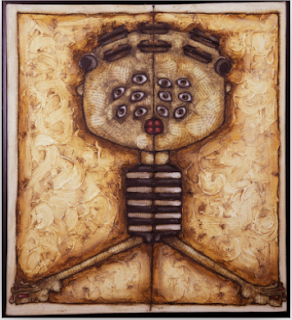Women in Latin America

me veo y no me siento, 1998 Raquel Paiewonsky Today I visited the Museum of Latin American Art (MOLAA) online and viewed the exhibition HERland: Women Artists in the MOLAA Collection . The work of art that caught my attention was Raquel Paiewonsky's me veo y no me siento , produced in 1998 using mixed media on canvas. The artwork is pictured here on the left. At first glance, it's quite off-putting. The image is what appears to be some kind of alien or unnatural being with a giant square-like head, eleven eyes, a rectangular torso without arms, and thin legs that are spread apart and end with gnarly-looking feet. It's not an image that will usually make people say, "wow that's beautiful." It is definitely not an image that gives its audience a feeling of quiet, calm, or serenity. In fact, it does quite the opposite, it gives the audience a feeling of repulsion and, at the same time, oddly enough, a strange fascination, and that's what the artist strives t...




